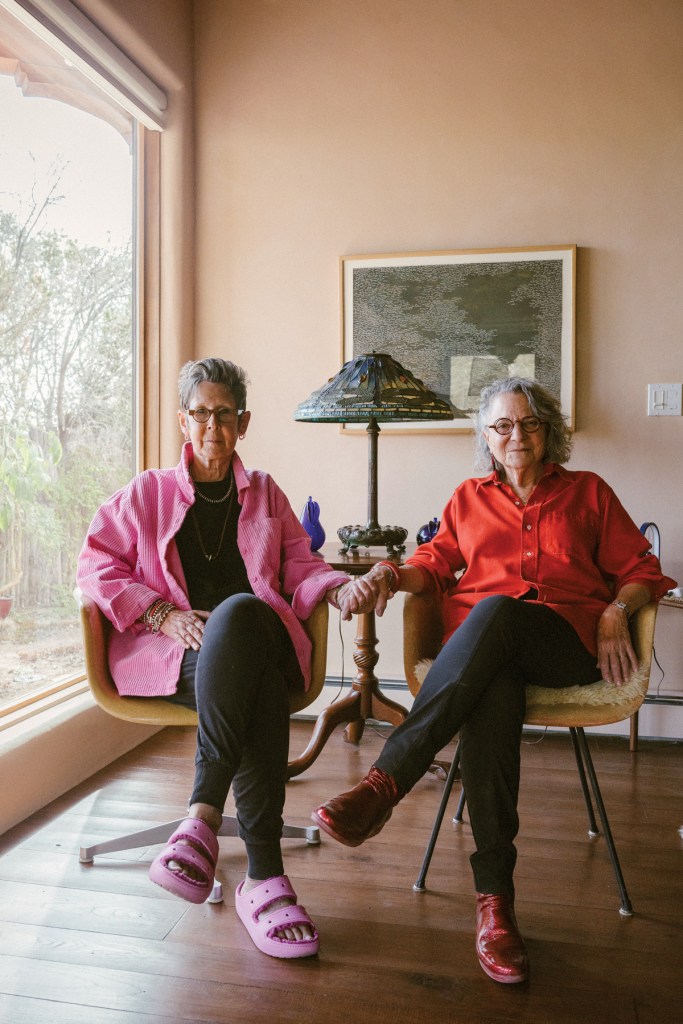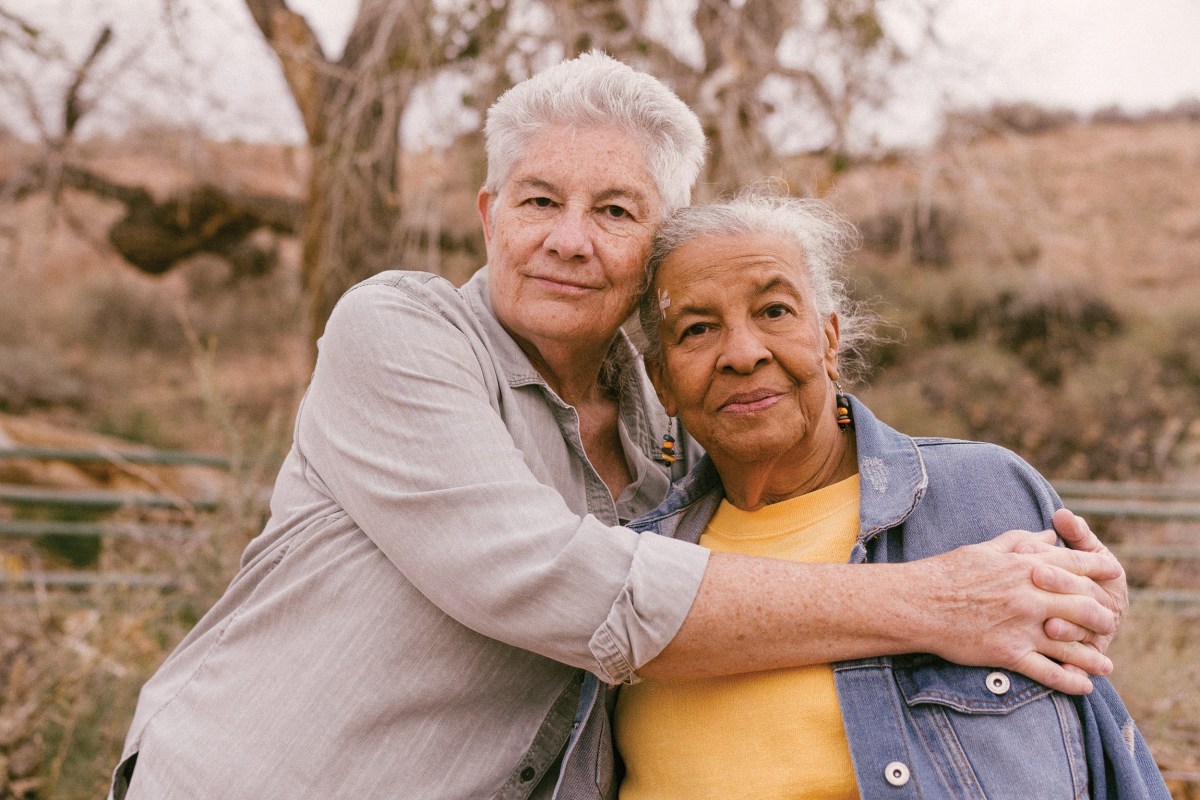I grew up in a small Catholic town in northern New Mexico. If I created a documentary about teenage lesbian life there in the 1990s, no one would appear in it — not even me. A photo shows me towering over the two friends I went to my junior prom with; one of them happened to be one of the two openly gay boys at my school.
In 2003, New Mexico named the whiptail lizard its state reptile. All whiptails are female, so they’ve been nicknamed the “lesbian lizard.” If threatened by a predator, a whiptail can detach her tail, leave it writhing on the ground, and dart to safety. But human lesbians have no such superpower. Once you’re identified in a small town, there’s nowhere you can go. I knew of older lesbians in town, but I wondered why there were none my age. Perhaps the older ones could live there because the creeping invisibility women often experience as they age freed them in some way.

Morgan Lieberman created her photographic series Hidden Once, Hidden Twice to make women like the ones surrounding me visible. Lieberman’s project focuses on lesbian women over 62 who are in loving long-term partnerships. When she was growing up, she said, she never encountered queer women. This series is a way to honor and recognize the women who created an opening we could step into.
At age 7, I sometimes slept over at my friend Angelica’s house. Angelica had two moms. I have no memory of surprise or curiosity at this fact, only a memory of one of them pulling too hard when she brushed my hair. Given the size of my small hometown, older lesbians seemed to be everywhere: the woman who owned the construction company and her partner, the masseuse; the doctor couple and the bookstore owners; the writer and her horse-therapist partner; the woman who worked at the tiny health food store; the farming couple with the best green chile at the Tri-County Farmers’ Market.

Cathy: She’s taught me to take risks. I mean, I would say that we are very complementary in a lot of ways, and we’ve managed to overcome a lot in our years together. And during that time, we couldn’t have done it without teaching and learning from each other.

Gevin and Cathy, Van Nuys, California (left)
Gevin: Well, we were homeless for two years when we first got together; when we first started dating, we had both come out of very, very tumultuous relationships. And so we ended up finding each other through all of that ridiculousness. And neither of us had anywhere to go. I mean, every night we would see the sunset on the ocean. We lived in my van together for two years. We were like two peas in a pod anyway.
Bev and Lisa, Phoenix, Arizona (right)
Lisa: Bev and I share core values in ways that I think make our relationship able to last.
Bev: Who takes out the garbage? Who takes care of the yard? Who takes care of the house? Who does this? Who does that? I mean, that’s the simple stuff.
There were plenty of women I could model myself on, and yet, it took me longer than most to see myself in their faces. The doctors watched me grow up, endure a short, terrible marriage, learn to be a single parent, and finally, at age 28, come out. The writer taught me creative writing in ninth grade and speech in college, and later listened patiently as I rattled off my confused thoughts and questions about my sexuality and my fears that my kids could be taken from me. She and her partner have since become my good friends.
Cottonwood tree, red earth mesa, turquoise jewelry, adobe wall — I know who these New Mexican couples are. Their faces remind me of home, too. It’s good to be back; I lived eight long years in Montana, where I avoided holding my girlfriend’s hand in public for fear of being attacked.




Maggie and Kristen, Salt Lake City, Utah (top left)
Kristen: I was in private practice taking care of the AIDS patients, and no one would help me. So I was working 24/7 and it was too much. So she went to PA school and joined me, and then we worked together 24/7. That’s how we got together.
Maggie: Often you read about people that work together that have relationships together. They don’t stay together, or you read about when you retire that your relationship dissolves. But ours didn’t. We just kind of transferred some of that to different things. We like birding, we do. She loves birds. I love to drive. So we say, oh, let’s go see that bird somewhere else. Oh, I’m going to drive you there.
Billie and Gay, Santa Fe, New Mexico (top right)
Billie: It was a wonderful time, when we got together. She had the most innocent broad smile I’d ever seen in my life. A real joy, a joyous look about her. It still blows my mind.
Jewelle and Diane, Oakland, California (bottom left)
Jewelle: She’s provided for me a sense of unconditional support for whatever I’m doing.
Diane: When we first got together, I had never felt so full or complete and couldn’t imagine that there could be even more than that. And every day there is still more than that.
Claire and Harriet, Santa Fe, New Mexico (bottom right)
Harriet: The morning of February 20th, 2004, Claire went to work as usual and heard on the …
Claire: … radio on NPR that in Sandoval County, New Mexico, the clerk of courts is issuing same-sex licenses that day. So I called her up and I said, “Honey, what are you doing for lunch? Want to get married?”
I can’t quite describe the ache I feel as I study the faces of the women in Lieberman’s photographs. Though I don’t know them, and they live in many places across the West, they seem familiar to me now. I feel their gazes on me. I feel a kinship with them and gratitude for the battles they fought that allow me and my nonbinary kid to be freer. I’m also envious, because they experienced a deeper kind of community, complete with lesbian bars and secret codes, that seems to have faded away. I wonder, too, if there will be someone sharing the frame with me when I reach their ages. When my kids were little, I hoped — I willed — unsuccessfully that each woman I dated would become another parent figure to my children. If Angelica could have two moms in rural New Mexico in the 1980s, surely my own kids could have two moms in 2012.


Hoodie and Kathy, Bicknell, Utah (left)
Hoodie: It was after we had met at the campout. I saw this little yellow Toyota driving next to me. And I just thought, you know what? She should be in this car with me, or I should be in that car with her. I just really liked her man. But it’s, man, 34 years. It blows me away.
Kate and Tish, Santa Cruz, California (right)
Tish: We met at the Santa Cruz Beach Boardwalk. I saw Kate walk by with who I thought was her partner. And I was just like, “You’re like, oh, there’s some other lesbians.” And I just was checking them out and they were checking me out and they were smiling. I was sort of smiling to myself.
Kate: For me, it was love at first sight, that smile.
As I remember my teens and early 20s, I recall that the older lesbians in my hometown took on almost a mythic quality to me, as if they had somehow found a way out of societal constraints that was not available to me. I remember wishing that I was lesbian, too, as if it was almost too hard to imagine that I already was.
As I study the faces of these women who have lived more life than I have, I want to know what they know. In my yearning for lesbian community, I conjure up potlucks, exes dating exes, leftist political action and the persistent soundtrack of the Indigo Girls. When I was 14, I traveled an hour from my hometown to see the Indigo Girls perform at the Paolo Soleri Amphitheater in Santa Fe. It was my first concert. A thunderstorm hit as Amy and Emily began to play, but the crowd of lesbians stood in the pounding rain singing, their hair and clothing flattened against their bodies, until the concert ended. I was exhilarated for reasons I was not able to name until I came out 14 years later.
My first year back in New Mexico, I walked to the Santa Fe Plaza to watch the pride parade with my teen. One retirement home bus after another rolled slowly by. Gay and lesbian seniors waved rainbow flags from the bus windows and smiled at us — two younger generations, following in their giant footsteps. We smiled back from the sidewalk.

Dinah: I want Sally to quit saying she’s only going to be around five more years. If that’s true, which I know it’s not, but if that’s true, we’re going to enjoy every single one of those days. Sally: We share a lot. We have a lot in common, and it’s good. Yeah, it’s better than good.
Emily Withnall edits an arts and culture magazine in Santa Fe, New Mexico. Her work has appeared in The New York Times, Al Jazeera, Orion, Kenyon Review and elsewhere. Emily’s work can be read at www.emilywithnall.com.
Morgan Lieberman’s photographs were supported by a 2023 High Country News Western Communities photo essay grant, and are part of her ongoing project documenting older lesbian partnerships around the country.
We welcome reader letters. Email High Country News at editor@hcn.org or submit a letter to the editor. See our letters to the editor policy.
This article appeared in the March 2024 print edition of the magazine with the headline “Faces like mirrors.”


